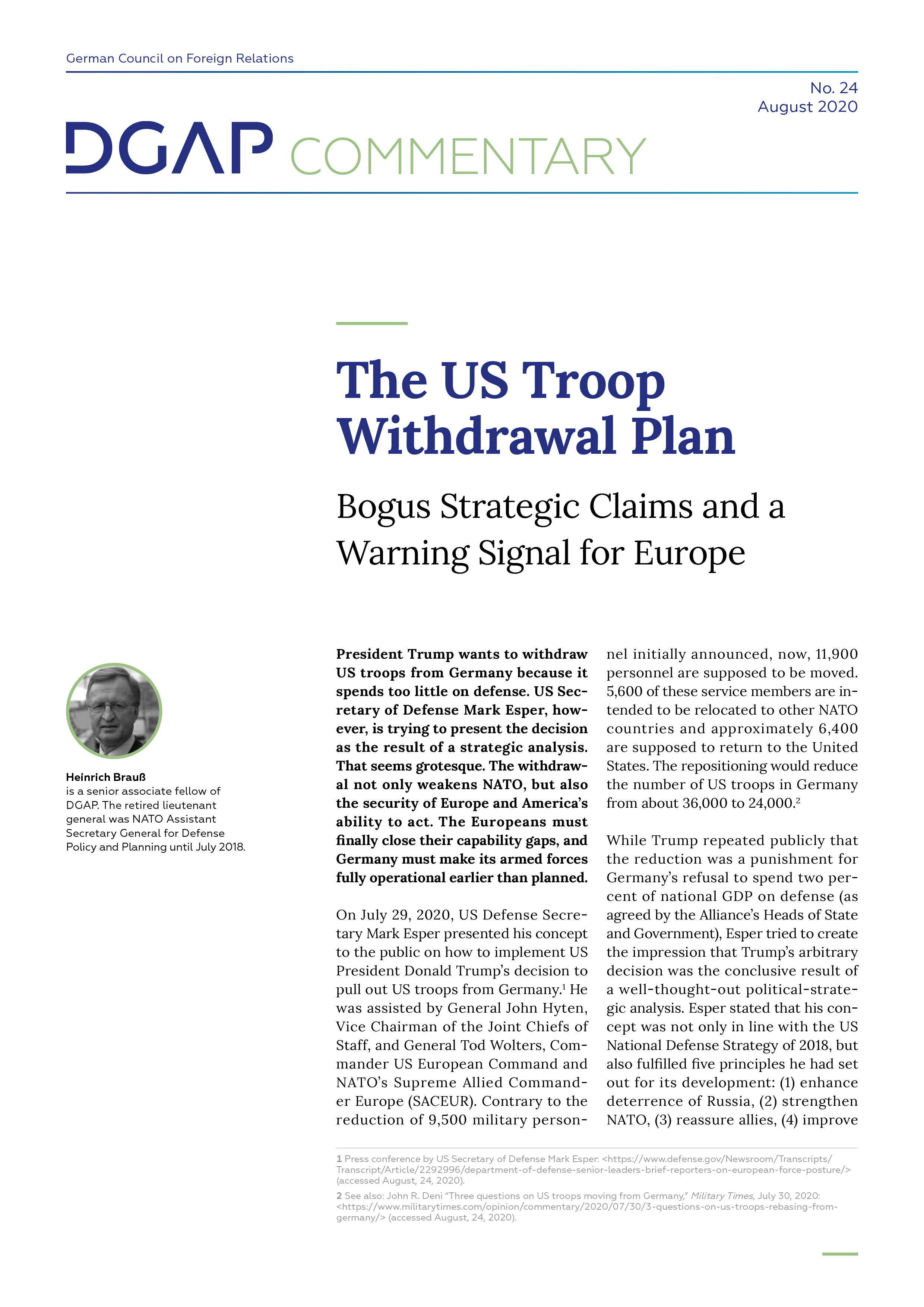On July 29, 2020, US Defense Secretary Mark Esper presented his concept to the public on how to implement US President Donald Trump’s decision to pull out US troops from Germany. He was assisted by General John Hyten, Vice Chairman of the Joint Chiefs of Staff, and General Tod Wolters, Commander US European Command and NATO’s Supreme Allied Commander Europe (SACEUR). Contrary to the reduction of 9,500 military personnel initially announced, now, 11,900 personnel are supposed to be moved. 5,600 of these service members are intended to be relocated to other NATO countries and approximately 6,400 are supposed to return to the United States. The repositioning would reduce the number of US troops in Germany from about 36,000 to 24,000.
While Trump repeated publicly that the reduction was a punishment for Germany’s refusal to spend two percent of national GDP on defense (as agreed by the Alliance’s Heads of State and Government), Esper tried to create the impression that Trump’s arbitrary decision was the conclusive result of a well-thought-out political-strategic analysis. Esper stated that his concept was not only in line with the US National Defense Strategy of 2018, but also fulfilled five principles he had set out for its development: (1) enhance deterrence of Russia, (2) strengthen NATO, (3) reassure allies, (4) improve strategic flexibility as well as the US European Commander’s operational flexibility, and (5) care for the service members concerned and their families. Analysis of the proposed individual measures as they have been presented thus far, however, demonstrates that the concept largely fails to meet these principles.
The US is reducing its commitment to the security of its allies and snubbing its main European ally.
Key elements of the proposed troop relocation include: (1) Moving Headquarters US European Command from Stuttgart to Mons (Belgium) where it would be co-located with the Supreme Headquarters Allied Powers Europe (SHAPE); (2) repositioning of the 2nd Cavalry Regiment, a brigade equipped with Stryker wheeled armored fighting vehicles, from Vilseck (Bavaria) back to the United States; (3) relocation of a F-16 fighter squadron from Spangdahlem (Rhineland-Palatinate) as well as two army battalions from Grafenwöhr (Bavaria) to Italy; (4) repositioning of three brigade headquarters, an air defense artillery battalion, and an engineering battalion to Belgium; (5) moving elements of the Headquarters V (US) Corps from the US to Poland (in addition to the reinforcements agreed upon by Poland and the United States last year encompassing, inter alia, some 1,000 military personnel). (6) Finally, US Stryker units would begin continuous rotations in the Black Sea region to ensure a more “enduring” US military presence there.
The plan’s core is the withdrawal of the Stryker brigade from Europe, which would reduce the US land forces in Europe by practically a third – from three to two combat brigades. This is what matters most, politically and militarily. The US forces in Europe make a decisive contribution to NATO’s deterrence and defense capabilities. They play a vital role in reinforcing Allies located on the Alliance’s borders for their protection or defense. They serve as an essential deterrent in Europe. Consequently, he who intends to relocate a third of the US combat forces from Europe back to the United States (over a distance of more than 7,000 kilometers), weakens deterrence, and does not strengthen it. The plan damages NATO’s credibility and cohesion; and it impairs the security of the Eastern European Allies, as there would be fewer US combat units that could be rapidly deployed in regions where they would likely be needed most.
The withdrawal plan also carries several harmful political messages: the US is reducing its commitment to the security of its allies and snubs its main European ally Germany. Experience has shown that, contrary to Esper’s assurance, rotating units are not at their full strength. They signal less commitment and reliability than present troops (living with their families) who understand their mission precisely and constantly train for it. Interoperability of allied forces would suffer. Moreover, a US withdrawal would be a unilateral disarmament move without a reciprocal Russian step. This would do a disservice to arms control and mutual disarmament in Europe since Moscow is continuing its buildup of conventional forces in the Baltic region and has deployed intermediate-range nuclear-capable missiles that threaten almost all of Europe.
The claim that the Pentagon concept would increase the United States’ strategic flexibility for deployments in Europe and other regions is not convincing. Any deployment of forces from Germany – the central European hub – to peripheral regions, the Mediterranean, or the Near and Middle East (where America has strategic interests), is faster, more effective, and more cost-efficient than from the US across the Atlantic. In addition, the Stryker brigade is not earmarked for possible deployments in the Indo-Pacific region, as Esper admitted in response to questions from media representatives.
The security of Eastern Europe as a whole, especially that of the Baltic States, would be weakened.
It is equally obvious that positioning fewer troops in Europe does not increase the ability to act of the Commander US European Command, but rather limits it, even for military exercises. He would lack the Stryker units for rapid reaction in a crisis in support of regions that are exposed to a potential direct military threat, for example the Baltic region. It is also incomprehensible as to why an air defense battalion should be moved further west to Belgium when the battalion would be needed immediately in the east in the event of a crisis or conflict. Finally, the relocation of an F-16 fighter squadron from Spangdahlem weakens the fighter wing that would be indispensable as a first reinforcement in the Baltic region and for eliminating the anti-access/area-denial systems in Kaliningrad. In Aviano, Italy, on the other hand, there is already a US F-16 fighter wing. Esper’s reasoning that the repositioning would bring air forces from Germany closer to the Black Sea region insults the knowledge of the experts.
From a military perspective, the merging of all units of the 173rd Airborne Brigade in Italy is plausible. Deploying elements of the Headquarters V Corps US to Poland for joint defense planning is welcome. It would also make sense to co-locate SHAPE, the Headquarters US European Command, and the US Special Operations Command in Mons since NATO’s SACEUR is, at the same time, Commander of all US forces in Europe. But is such a large command base necessary? In a war, it would be a priority target. The development of adequate infrastructure would take years and would be very costly, especially since the SHAPE building is in great need of renovation.
If overall deterrence is not strengthened and NATO is weakened by reducing the responsiveness and effectiveness of US forces in Europe, there can be no talk of “reassuring allies.” While there is no doubt that the security of Romania and Bulgaria would benefit from the presence of rotating US units, the security of Eastern Europe as a whole, and especially that of the Baltic States, would be weakened. Additionally, Esper’s concept means considerable uncertainty for the affected members of the US armed forces. No one knows exactly where and when the personnel would be transferred – let alone whether the plan is even feasible.
The plan is also a wake-up call for Germany and Europe.
Lieutenant General (retd.) Ben Hodges, former Commander US Army Europe, was recently quoted as saying that Secretary of Defense Esper had done his best to minimize the damage of a bad and false decision. One can surely agree with that. Details are not yet known. The concept is now being elaborated, but it remains a bogus strategic claim. One can only hope that the representatives of the US Congress will understand not only the questionability of the plan, but also the scale of its costs and the time needed to prepare the necessary infrastructure – and will therefore not be providing the resources for its implementation.
Nevertheless, the plan is also a wake-up call for Germany and Europe. The reliable commitment of the United States to the security of Europe remains indispensable. This is also in America’s own strategic interest. If the United States wants to be able to withstand the growing great power competition against China and Russia, Europe must remain a secure and stable partner. In the face of both growing regional and global challenges and dangers, as well as the global shift of power, all European nations must clearly do much more for their own security and the common transatlantic security, both politically and militarily.
The relocation plan gives Europe a taste of what it could be faced with if the United States is forced to really increase its strategic flexibility toward East Asia at Europe’s expense or reduce the forces and capabilities earmarked for reinforcement of Europe in a crisis. This would primarily concern US air and naval forces, as well as those ground forces that are deployable by air transport, such as the Stryker and the airborne brigades. Europe must finally fill the gaps that are emerging. For the German government, this means significantly accelerating achievement of the full operational readiness of its armed forces. Germany’s Defense Minister Annegret Kramp-Karrenbauer is aiming for this by 2031 – which is too late.



